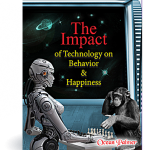Nothing has changed the talent development profession as much as the global recession’s propulsion of a heavily wired, increasingly dependent digital world. Innovation exploded, cost dropped, ease of use took quantum steps forward, and permeation mushroomed. User motivations grew from convenience to necessity. Information is everywhere — too much at times — and the challenge for talent development specialists morphed from traditional classroom teaching methods to a perplexing confusion about what to do, how to do it, and what could go wrong en route to positive change.
Six factors to consider when dealing with talent grooming.multi-generational workforces, and the need for enhanced workforce efficiency:
- The Impact of Technology on Behavior & Happiness. It took a two-decade foundation in behavioral understanding plus 1,500 hours of research to sort out, explain, and package key findings in the book I wrote by the same name. Having taught this in corporate and collegiate settings, suffice it to say that before you can influence a wired generation or digitally dependent corporation, you must understand the role technology has played in shaping, changing, and (at times) sabotaging behaviors. Technology’s impact varies dramatically from Millenniums to Boomers — plus those in between and beyond — but the keys include history, habits, trends, addiction symptoms, and what to expect from next-gen technological influence. This understanding should foundational for every organizational leadership team.
- Attention spans and reading trends. In tandem with rising digital addiction problems, shorter attention spans and skim reading are replacing concentration and content absorption. The challenge organizations face is a dilemma of choice: Should the information reside in the heads of the people or inside a box? Box repositories have a direct impact on many behavioral conclusions drawn and acted upon by employees, some of which negatively impact self-image and self-esteem. I am fond of saying that “Talent has options.” A highly mobile workforce governed more by the wants of the employee rather than the promise of a long-term career means organizations that invest heavily in people development face unwanted flight risks. As attention spans diminish and a growing majority worry little about knowing things and more about where they can find it, creative thinkers and problem-solvers diminish in number. Because thinkers and problem-solvers are highly valued attributes in a competitive job market, talent development and retention strategies need to know who to invest in and who not to.
- Mindfulness. ‘Mindfulness’ is a popular buzzword that umbrellas topics such as critical thinking (managing by fact), emotional intelligence (of self and others), contrarian thinking, behavior, work style recognition, and several other angles of “in the moment” acuity. This matters because Mindfulness is a huge determinant in whether someone is busy or efficiently productive. The world is full of busy people but increasingly shy of productive ones. Mindful people tend to make more proactive and purposeful time choice decisions and execute more efficiently than those who are not.
- Engagement. Organizations have four levels of engagement among workers. Some are fully engaged, which means they are “all in, all the time.” They carry their weight and sometimes more. Other workers are somewhat engaged, which means they do what they are told but little more. They are not seeking another job but will listen when the phone rings. The third group is somewhat disengaged, which means they do just enough to get by. Somewhat disengaged workers are looking for other opportunities and have paper on the street. The fourth group, those who are fully disengaged, are skating minimalists who collect paychecks but have no fire for excellence, don’t care much, and will leave at the next opportunity. Technology directly impacts engagement. Technology is a sterile thing — it has no personalty — and increasing engagement and total reliance on inanimate objects has significant behavioral ramifications.
- Maximizing “stick rates.” A ‘stick rate’ is how much of what is shared or taught is retained and applied. This is the Achilles heel of digital learning, as a skim-reading world of invisible pages feeds random access memory but not the archival retrieval of wisdom. The challenge for organizations in winning this tug-of-war (sorry for mixing metaphors) is finding a balance between making information convenient and developing people to make them more powerful.
- Explaining the “Why.” One of the major differences between working with older people and younger ones is that older workers had a more accepting and less challenging view of corporate methods than Millennials. Boomers accepted the “What to do.” Millennials test the “Why.” This is not a problem, but rather an opportunity. Emphasizing the Why and trolling for better methods regardless of those solutions’ points of origin is how an organization maximizes its full talent roster. Ideas matter, and real-time organizations couldn’t care less where better methods come from. Fostering a climate of Better & Smarter, and recognizing and rewarding solution-creators, is a great way to improve worker engagement and strengthen strategic retention.
Thanks for reading. Fire along any questions you have — I am always happy to answer them — and if you are curious about The Impact of Technology on Behavior & Happiness, grab a copy of the book. It explains in simple terms where we were, where we are, where we are headed, and what to do today to keep command of cranial air space. You will learn a lot, which was the book’s primary creation objective. You can link to The Impact by clicking the “Books” tab and jump right to it.
Best regards,

Available now in print & eBook. To order, click the “Book” link. For seminars and speaking engagements, please contact me directly: Ted@OceanPalmer.com
Thanks!
